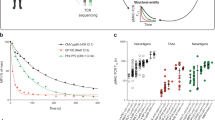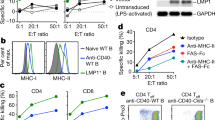Abstract
Multiple intravenous injections of a cDNA library, derived from human melanoma cell lines and expressed using the highly immunogenic vector vesicular stomatitis virus (VSV), cured mice with established melanoma tumors. Successful tumor eradication was associated with the ability of mouse lymphoid cells to mount a tumor-specific CD4+ interleukin (IL)-17 recall response in vitro. We used this characteristic IL-17 response to screen the VSV-cDNA library and identified three different VSV-cDNA virus clones that, when used in combination but not alone, achieved the same efficacy against tumors as the complete parental virus library. VSV-expressed cDNA libraries can therefore be used to identify tumor rejection antigens that can cooperate to induce anti-tumor responses. This technology should be applicable to antigen discovery for other cancers, as well as for other diseases in which immune reactivity against more than one target antigen contributes to disease pathology.
This is a preview of subscription content, access via your institution
Access options
Subscribe to this journal
Receive 12 print issues and online access
$209.00 per year
only $17.42 per issue
Buy this article
- Purchase on Springer Link
- Instant access to full article PDF
Prices may be subject to local taxes which are calculated during checkout





Similar content being viewed by others
References
Pardoll, D.M. Cancer vaccines. Nat. Med. 4, 525–531 (1998).
Park, T.S., Rosenberg, S.A. & Morgan, R.A. Treating cancer with genetically engineered T cells. Trends Biotechnol. 29, 550–557 (2011).
Uchi, H. et al. Unraveling the complex relationship between cancer immunity and autoimmunity: lessons from melanoma and vitiligo. Adv. Immunol. 90, 215–241 (2006).
Koos, D. et al. Tumor vaccines in 2010: need for integration. Cell. Immunol. 263, 138–147 (2010).
Robert, C. et al. Ipilimumab plus dacarbazine for previously untreated metastatic melanoma. N. Engl. J. Med. 364, 2517–2526 (2011).
Rosenberg, S.A. & Dudley, M.E. Adoptive cell therapy for the treatment of patients with metastatic melanoma. Curr. Opin. Immunol. 21, 233–240 (2009).
Drake, C.G., Jaffee, E.M. & Pardoll, D.M. Mechanisms of immune evasion by tumors. Adv. Immunol. 90, 51–81 (2006).
Poschke, I., Mougiakakos, D. & Kiessling, R. Camouflage and sabotage: tumor escape from the immune system. Cancer Immunol. Immunother. 60, 1161–1171 (2011).
Gogas, H. et al. Prognostic significance of autoimmunity during treatment of melanoma with interferon. N. Engl. J. Med. 354, 709–718 (2006).
Daniels, G. et al. A simple method to cure established tumors by inflammatory killing of normal cells. Nat. Biotechnol. 22, 1125–1132 (2004).
Ferrone, S. Immunotherapy dispenses with tumor antigens. Nat. Biotechnol. 22, 1096–1098 (2004).
Kottke, T. et al. Antitumor immunity can be uncoupled from autoimmunity following heat shock protein 70-mediated inflammatory killing of normal pancreas. Cancer Res. 69, 7767–7774 (2009).
Kottke, T. et al. Induction of hsp70-mediated, Th17 autoimmunity can be exploited as immunotherapy for metastatic prostate cancer. Cancer Res. 67, 11970–11979 (2007).
Sanchez-Perez, L. et al. Killing of normal melanocytes, combined with hsp70 and CD40L expression, cures large established melanomas. J. Immunol. 177, 4168–4177 (2006).
Sanchez-Perez, L. et al. Potent selection of antigen loss variants of B16 melanoma following inflammatory killing of melanocytes in vivo. Cancer Res. 65, 2009–2017 (2005).
Turk, M.J., Wolchok, J.D., Guevara-Patino, J.A., Goldberg, S.M. & Houghton, A.N. Multiple pathways to tumor immunity and concomitant autoimmunity. Immunol. Rev. 188, 122–135 (2002).
Alvarez-Breckenridge, C. & Chiocca, E.A. A viral strategy to ambush tumors. Nat. Med. 17, 784–785 (2011).
Kottke, T. et al. Broad antigenic coverage induced by viral cDNA library-based vaccination cures established tumors. Nat. Med. 17, 854–859 (2011).
Braxton, C.L., Puckett, S.H., Mizel, S.B. & Lyles, D.S. Protection against lethal vaccinia virus challenge by using an attenuated matrix protein mutant vesicular stomatitis virus vaccine vector expressing poxvirus antigens. J. Virol. 84, 3552–3561 (2010).
Bridle, B.W. et al. Vesicular stomatitis virus as a novel cancer vaccine vector to prime antitumor immunity amenable to rapid boosting with adenovirus. Mol. Ther. 17, 1814–1821 (2009).
Bridle, B.W. et al. Potentiating cancer immunotherapy using an oncolytic virus. Mol. Ther. 18, 1430–1439 (2010).
Cobleigh, M.A., Bouonocore, L., Uprichard, S.L., Rose, J.K. & Robek, M.D. A vesicular stomatitis virus-based hepatitis B virus vaccine vector provides protection against challenge in a single dose. J. Virol. 84, 7513–7522 (2010).
Diaz, R.M. et al. Oncolytic immunovirotherapy for melanoma using Vesicular Stomatitis Virus. Cancer Res. 67, 2840–2848 (2007).
Geisbert, T.W. et al. Single-injection vaccine protects nonhuman primates against infection with marburg virus and three species of ebola virus. J. Virol. 83, 7296–7304 (2009).
Qiao, J. et al. Purging metastases in lymphoid organs using a combination of antigen-nonspecific adoptive T cell therapy, oncolytic virotherapy and immunotherapy. Nat. Med. 14, 37–44 (2008).
Schwartz, J.A. et al. Potent vesicular stomatitis virus-based avian influenza vaccines provide long-term sterilizing immunity against heterologous challenge. J. Virol. 84, 4611–4618 (2010).
Guevara-Patino, J.A. et al. Optimization of a self antigen for presentation of multiple epitopes in cancer immunity. J. Clin. Invest. 116, 1382–1390 (2006).
Guevara-Patino, J.A., Turk, M.J., Wolchok, J.D. & Houghton, A.N. Immunity to cancer through immune recognition of altered self: studies with melanoma. Adv. Cancer Res. 90, 157–177 (2003).
Overwijk, W.W. et al. Tumor regression and autoimmunity after reversal of a functionally tolerant state of self-reactive CD8+ T cells. J. Exp. Med. 198, 569–580 (2003).
Overwijk, W. et al. Tumor regression and autoimmunity after reversal of a functionally tolerant state of self-reactive CD8+ T cells. J. Exp. Med. 198, 569–580 (2003).
Galivo, F. et al. Interference of CD40L-mediated tumor immunotherapy by oncolytic VSV. Hum. Gene Ther. 21, 439–450 (2010).
Galivo, F. et al. Single-cycle viral gene expression, rather than progressive replication and oncolysis, is required for VSV therapy of B16 melanoma. Gene Ther. 17, 158–170 (2010).
Wongthida, P. et al. VSV oncolytic virotherapy in the B16 model depends upon intact MyD88 signaling. Mol. Ther. 19, 150–158 (2011).
Willmon, C. et al. Vesicular stomatitis virus-induced immune suppressor cells generate antagonism between intra-tumoral oncolytic virus and cyclophosphamide. Mol. Ther. 19, 140–149 (2011).
Hogquist, K.A. et al. T cell receptor antagonistic peptides induce positive selection. Cell 76, 17–27 (1994).
Hall, A. & Brown, R. Human N-ras: cDNA cloning and gene structure. Nucleic Acids Res. 13, 5255–5268 (1985).
Shibata, K., Takeda, K., Tomita, Y., Tagami, H. & Shibahara, S. Downstream region of the human tyrosinase-related protein gene enhances its promoter activity. Biochem. Biophys. Res. Commun. 184, 568–575 (1992).
Suzuki, H., Hosokawa, Y., Nishikimi, M. & Ozawa, T. Structural organization of the human mitochondrial cytochrome c1 gene. J. Biol. Chem. 264, 1368–1374 (1989).
Rausch, M.P. et al. GILT accelerates autoimmunity to the melanoma antigen tyrosinase-related protein 1. J. Immunol. 185, 2828–2835 (2010).
Tanaka, S. et al. Target killing of carcinoembryonic antigen (CEA) - producing cholangiocarcinoma cells by polyamidoamine dendrimer-mediated transfer of an Epstein-Barr virus (EBV)-based plasmid vector carrying the CEA promoter. Cancer Gene Ther. 7, 1241–1249 (2000).
Thomas, D.A. & Massague, J. TGF-beta directly targets cytotoxic T cell functions during tumor evasion of immune surveillance. Cancer Cell 8, 369–380 (2005).
Linardakis, E. et al. Enhancing the efficacy of a weak allogeneic melanoma vaccine by viral fusogenic membrane glycoprotein-mediated tumor cell-tumor cell fusion. Cancer Res. 62, 5495–5504 (2002).
Fernandez, M., Porosnicu, M., Markovic, D. & Barber, G.N. Genetically engineered vesicular stomatitis virus in gene therapy: Application for treatment of malignant disease. J. Virol. 76, 895–904 (2002).
Acknowledgements
We thank T. Higgins for expert secretarial assistance. This work was supported by the Richard M. Schulze Family Foundation, the Mayo Foundation, Cancer Research UK, the US National Institutes of Health grants R01 CA107082, R01CA130878 and R01 CA132734, and a grant from Terry and Judith Paul. MyD88 KO mice (MyD88−/−) were a kind gift from L. Pease, Mayo Clinic.
Author information
Authors and Affiliations
Contributions
J.P., T.K., J.T., F.G., P.W., R.M.D., D.R. and E.I. ran the experiments. J.P., T.K., L.P., H.P., K.H., P.S., A.M. and R.V. conceived the experimental approach and planned the experiments. J.P., T.K., H.P., K.H., P.S., A.M. and R.V. wrote the manuscript.
Corresponding author
Ethics declarations
Competing interests
The authors declare no competing financial interests.
Supplementary information
Supplementary Text and Figures
Supplementary Figure 1 (PDF 558 kb)
Rights and permissions
About this article
Cite this article
Pulido, J., Kottke, T., Thompson, J. et al. Using virally expressed melanoma cDNA libraries to identify tumor-associated antigens that cure melanoma. Nat Biotechnol 30, 337–343 (2012). https://doi.org/10.1038/nbt.2157
Received:
Accepted:
Published:
Issue Date:
DOI: https://doi.org/10.1038/nbt.2157
This article is cited by
-
Oncolytic virotherapy induced CSDE1 neo-antigenesis restricts VSV replication but can be targeted by immunotherapy
Nature Communications (2021)
-
APOBEC3B-mediated corruption of the tumor cell immunopeptidome induces heteroclitic neoepitopes for cancer immunotherapy
Nature Communications (2020)
-
Melittin-lipid nanoparticles target to lymph nodes and elicit a systemic anti-tumor immune response
Nature Communications (2020)
-
Oncolytic Viruses: Priming Time for Cancer Immunotherapy
BioDrugs (2019)
-
Oncolytic viruses as engineering platforms for combination immunotherapy
Nature Reviews Cancer (2018)



